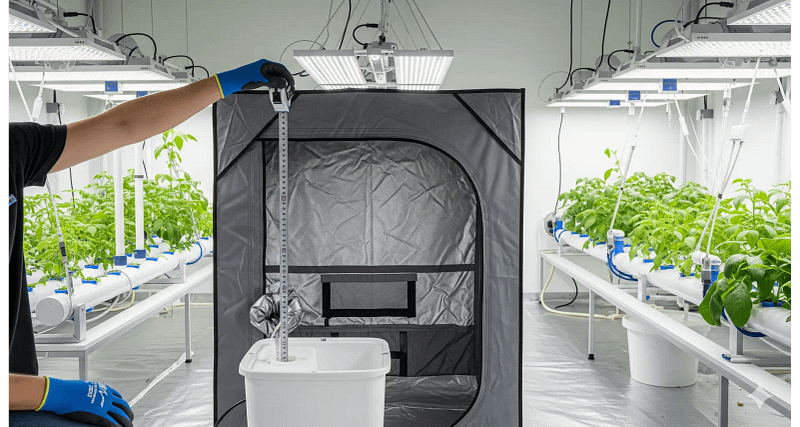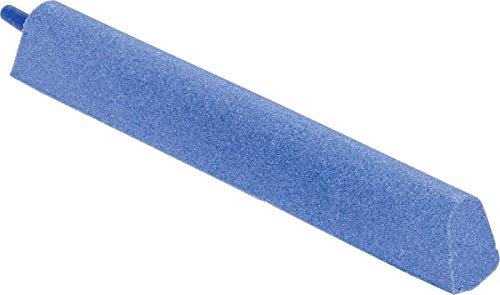I once undersized a pump for a 40-plant NFT system in 2020. The pump ran hot, the flow rate was a joke, and by the end of the day, half the plants on the far end of the manifold were gasping for water. The carnage was real. My lettuce died from a $20 pump mistake, and I learned a lesson that you can only learn from a flooded basement and a dead crop. This guide is your tactical ops manual for a properly sized pump. I’ve spent the last eight years building, breaking, and testing every pump I could get my hands on. My goal is to prevent you from making the same stupid mistakes I did. Stop guessing. Start growing with precision.
WARNING: Always oversize pumps by 20% for safety. Product links are for educational purposes.
The 3 Pump Killers (Head Height, GPH, Manifold Friction)
Let’s demystify the science. A properly sized pump isn’t rocket science; it’s a simple game of fluid dynamics. Your pump has three enemies: gravity, volume, and friction.
- Head Height: This is the vertical distance your pump has to push water up. Think of it as how hard your pump has to fight gravity. The higher the vertical lift, the more pressure is lost, and the less flow you get. My “aha!” moment was realizing that the GPH rating on the box is a lie. That number is measured at 0 head height, in a perfect lab. In the real world, you’ll never get that number.
- GPH (Gallons Per Hour): This is the volume of water your pump can move in a given time. Your system has a specific volume, and your pump needs to be able to turn that volume over at least a couple of times per hour. For a DWC system, a minimum flow of 2x tank volume/hour is a non-negotiable.
- Manifold Friction: This is the pressure your tubing, fittings, and nozzles steal from your pump. It’s an invisible force that can cripple your system. Manifold friction is like drinking through a bent straw—each curve, turn, and a narrowed section steals a little bit of the pressure your pump is working so hard to create.
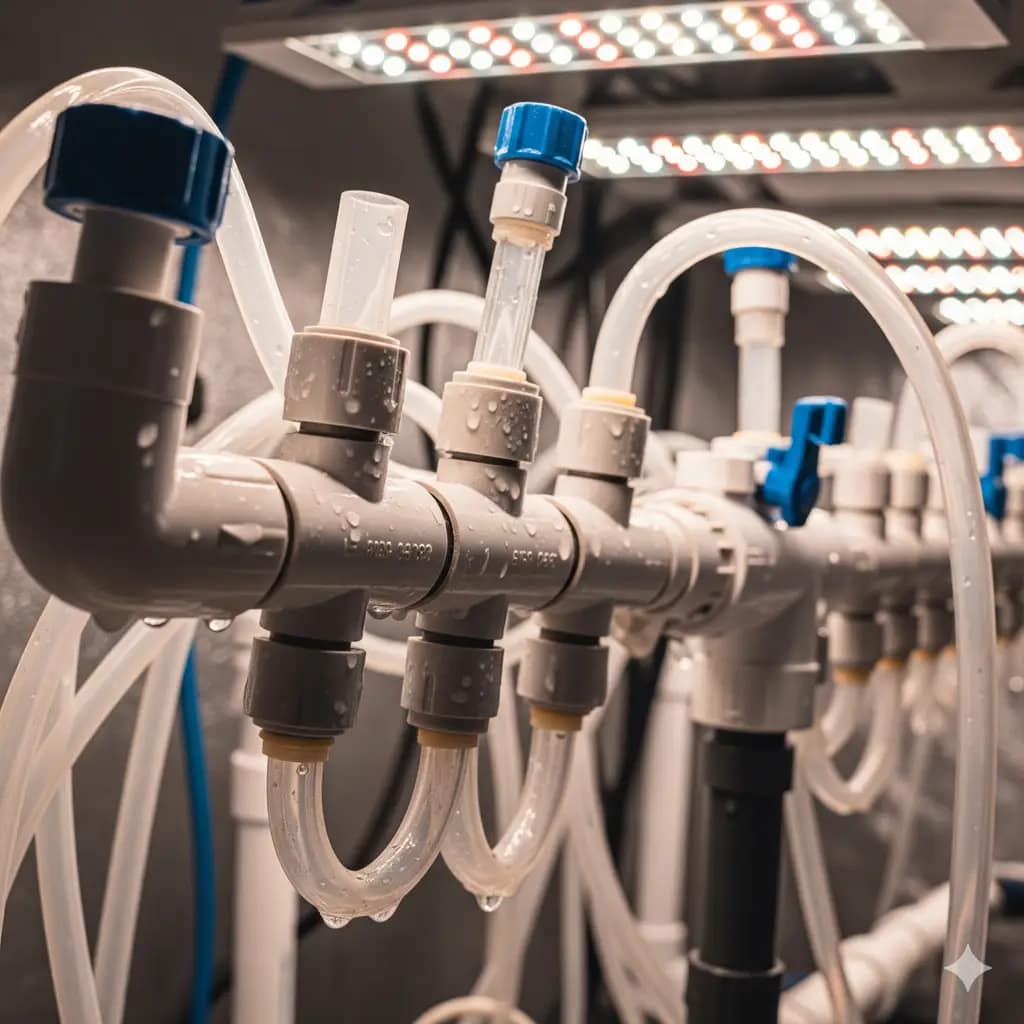
The Exact Math for Your System (No PhD Required)
Tired of guesswork? Here’s the math for mortals. You don’t need a PhD in irrigation engineering to get this right.
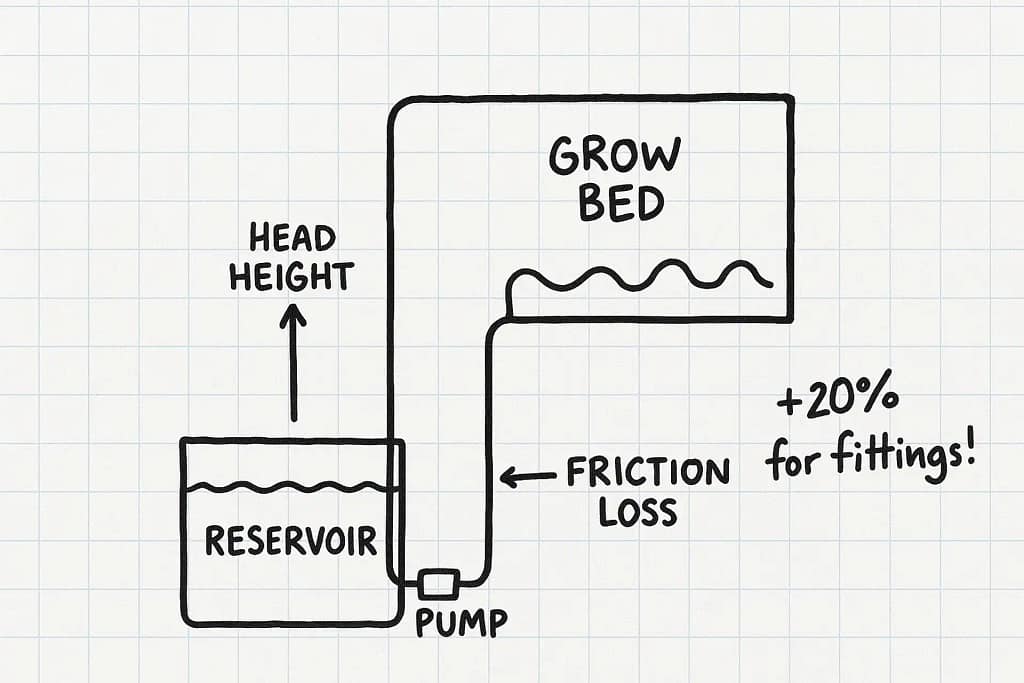
Step 1: Calculate Your REAL Total Head Height
- Measure the vertical distance from the water’s surface to the highest point in your system.
- Now, add 20-30% to that number. This accounts for the friction from every fitting, elbow, and foot of tubing. A 90° elbow can add the equivalent of 2 feet of head pressure. This is the single most important step everyone misses.
Step 2: Determine Your Minimum Flow
- DWC: Reservoir Volume (gallons) x 2 = Minimum GPH.
- NFT: You need a constant, thin film. Aim for 1-2 liters per minute per channel.
- Ebb & Flow: You need to fill your tray quickly. Calculate your flood volume (tray volume when flooded) and multiply it by 4. That’s your target GPH to fill it in 15 minutes.
Step 3: Find the Right Pump
- This is the key: Look at the pump’s performance chart (usually in the product images on Amazon). Find your real head height (from Step 1) on the vertical axis. Follow it across to the curve, then down to see the actual GPH the pump will deliver at that height. That number MUST be higher than your Minimum Flow from Step 2.
Manifold Mayhem: When Tubing Eats Your Flow Rate
Your tubing is your water’s highway. A manifold with too many turns or too small a diameter will cripple your flow.
- PVC vs. Silicone: PVC is great for a static setup, but a flexible silicone tube is a lifesaver for a dynamic one. Every foot of PVC can cause a pressure loss of 0.1 PSI, and every 90° elbow can add up to 2 feet of head.
- Size Matters: The diameter of your tubing matters. A 1/2-inch tube will have significantly less friction than a 1/4-inch tube. Don’t bottleneck your system with a tiny tube.
Submersible vs. Inline: The Dirty Truth from the Trenches
I’ve used both, and they both have their pros and cons. This isn’t theory; this is from my flooded basement.
Submersible:
- Pros: Cheap, quiet, and they help cool the reservoir water (a little).
- Cons: They add heat to your water from the motor, and they LOVE to clog with algae and debris. Cleaning them means fishing around in your nutrient soup.
Inline:
- Pros: More powerful, more energy-efficient, easier to maintain (mounted outside the res), and they don’t heat your nutrients.
- Cons: Louder, more expensive, and if you have a leak, it’s outside your reservoir (which is both a pro and a con).
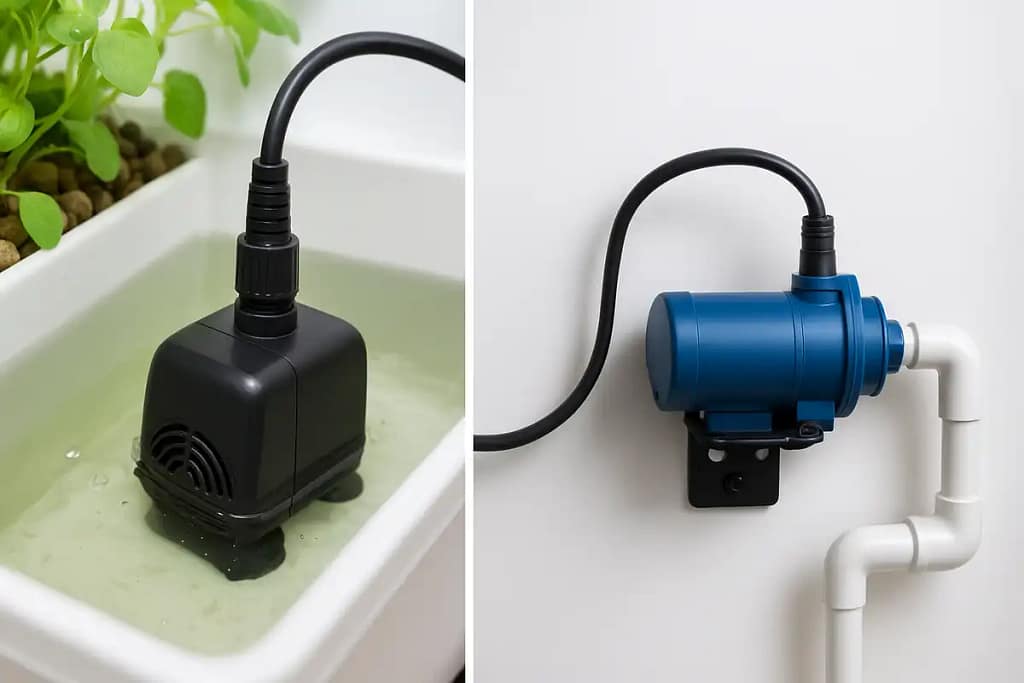
My Verdict: For a small, single-reservoir DWC system, a good submersible is fine. But for anything larger—especially RDWC or multi-zone systems—an inline pump is the only way to go. The reliability and efficiency are worth the investment.
Troubleshooting Flow Disasters (Before They Happen)
- Clogged Impellers: The classic killer. Debris gets sucked in and everything stops. The Fix: A $2 paint strainer bag over the pump intake. It’s the cheapest and most effective insurance you can buy.
- Air-locks: A bubble gets stuck, the pump screams, and nothing comes out. The Fix: Tilt the pump or give the outlet line a shake to bleed the air out.
- Cavitation: The pump is sucking air instead of water, usually because the water level is too low or the pre-filter is clogged. It sounds like the pump is chewing on rocks. The Fix: Top up your reservoir and clean your filter!
Your Crop’s Insurance Policy: Backup & Redundancy
Your pump is your plant’s lifeline. A failure can cause roots to drown and die in hours. After my flood, redundancy became non-negotiable.
My Strategy: For any system larger than a single bucket, I use two smaller pumps instead of one large one. If one fails, the other keeps everything alive. The combined GPH should meet your needs. Having a spare, inexpensive pump on the shelf is also a brilliant move.
The Ultimate Fix: Plug your main pump into a simple UPS (Uninterruptible Power Supply). It’s not just for computers. During a brief power outage, it’ll keep your bubbles flowing and your plants alive. Trust me, your future self will thank you.
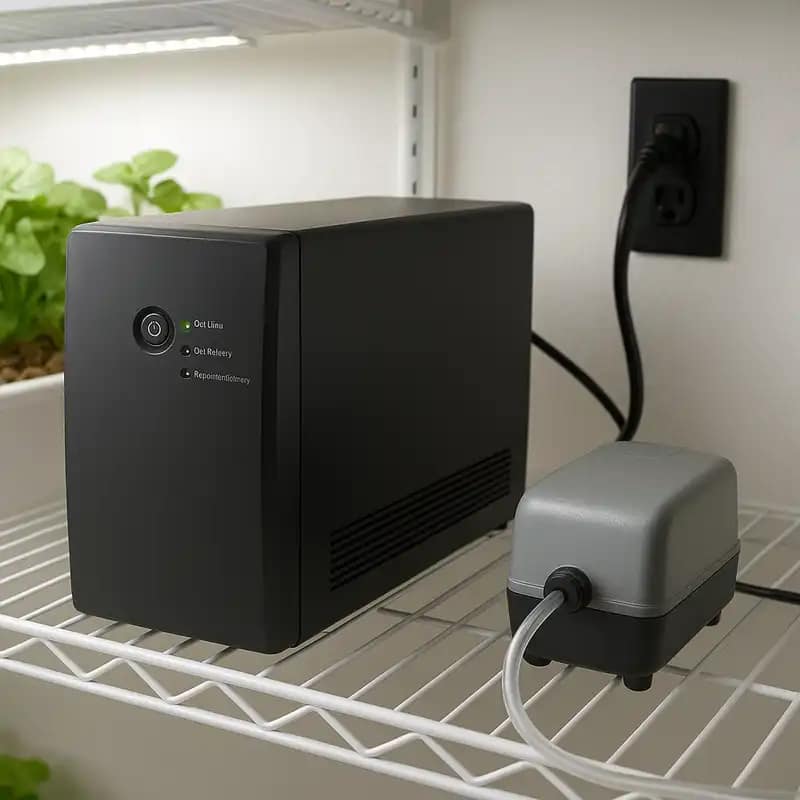
Pumps That Won’t Quit
These are the pumps I trust with my crops. They’ve been torture-tested in saltwater, clay, and algae soup.
Vivosun 800 GPH Submersible Water Pump
An energy-efficient pump with adjustable flow control, suitable for medium-sized hydroponic systems requiring high head pressure performance.
- Specs & Dimensions: 4.33*3.5*4.1 inches; Max flow rate: 800 GPH (3000L/H); Max lift height: up to 10 ft.; Wattage: 24W; …
- Adjustable Flow Rate: Water flow can be adjusted via the control knob and change different nozzles to meet the water pre…
- Detachable & Cleanable: This powerful yet small-sized water pump is easy to hide and disguise; No tools are necessary fo…
Why Growers Love It:
- Precision Flow Control: Dial in exact GPH output (200-800 range) to match system requirements, eliminating guesswork.
- High-Head Performance: Maintains strong flow even at 8-foot head heights, defying typical submersible pump limitations.
- Cool Operation: Brushless DC motor reduces heat transfer to nutrient reservoirs, preventing root stress.
Grower’s Notes:
- Non-Detachable Cord: Fixed cable length may require extensions for some setup configurations.
- Silt Sensitivity: Requires pre-filtering in systems with organic additives to prevent clogging.
Bottom Line for Growers: The ultimate workhorse for RDWC or multi-bucket systems where head height and precision flow are critical. Check Price on Amazon.
EcoPlus 793 GPH Commercial Pump
A commercial-grade pump designed for large systems, delivering robust flow rates and exceptional durability.
- Widely used to provide oxygen in aquariums, fish farms and hydroponic systems
- Includes chrome air manifold with 6 adjustable flow outlet valves
- Cylinders and pistons are made of premium materials, making the pump strong and durable
Top-Shelf Features:
- Industrial Reliability: Sealed motor compartment withstands continuous 24/7 operation without failure.
- High-Volume Flow: Moves 793 GPH effortlessly, ideal for systems up to 100 gallons.
- Thermal Protection: Auto-shutoff prevents overheating during unexpected blockages or dry runs.
A Word of Caution:
- Power Consumption: Draws 45W – ensure your electrical circuit can handle the load.
- Size Limitations: Larger footprint may not fit standard 5-gallon bucket openings.
Who This Is For: Commercial growers or serious enthusiasts running large RDWC or multi-tower systems. See Latest Discount.
Hygger 53 GPH Mini Submersible Pump
A compact, energy-efficient pump perfect for small-scale DWC or NFT systems where space and noise are concerns
- [ Fits Most Water Features ] Pump dimension: 2.4 x 1.7 x 2inch. This is a very small & compact water pump, can be used i…
- [ Comes with 2 Nozzels ] Voltage AC 110-120V/60Hz, 3 watt water pump. It comes with a 5/16 inch nozzle and a 1/2 inch no…
- [ Ultra Quiet & Adjustable ] With the use of durable small motor, the sound of the water pump will be very small. You ca…
Root-Level Benefits:
- Whisper-Quiet Operation: Runs below 25 dB, ideal for apartment grows or living spaces.
- Energy Efficient: Consumes only 6W, reducing long-term electricity costs.
- Complete Kit: Includes multiple nozzle adapters for seamless tubing connections.
Not a Perfect Fit For:
- Large Systems: Max capacity supports 2-3 buckets; beyond requires upgrades.
- High-Pressure Needs: Struggles with head heights above 3 feet..
Our Grow-O-Meter Says: The perfect entry-level pump for beginners or compact setups. Check Price on Amazon.
Active Aqua 4-Port Commercial Air Pump
A high-output air pump ensuring optimal oxygenation for DWC systems, preventing root suffocation.
- Super silent with multi-level muffler
- Special artificial rubber to keep a steady air flow output and pressure that can be Adjusted freely
- Low power consumption
Bloom & Boost:
- Multi-Outlet Control: Four ports with individual flow adjustments for custom aeration per bucket.
- Consistent Performance: Maintains stable pressure even during continuous operation.
- Vibration Dampening: Rubber feet and muffler design reduce noise to 40 dB.
Things to Consider:
- Heat Output: Generates mild warmth; mount away from reservoirs to avoid heat transfer.
- Stone Compatibility: Works best with low-resistance air stones.
Is It Right For Your Garden?
Essential for DWC growers prioritizing root health and oxygenation. See Latest Discount.
APC Back-UPS Pro 1000VA Battery Backup
A reliable UPS system providing emergency power during outages, critical for air and water pumps.
- APC 1000VA / 600W battery backup power supply
- 10 Outlets (NEMA 5-15R): 6 surge protector with battery backup; 4 outlets with Surge Protection Only. Powerchute UPS man…
- Sinewave UPS with Automatic Voltage Regulation (AVR), designed for high-end electronics, ideal battery backup for comput…
Grow Room Win:
- Instant Failover: Automatically switches to battery power within milliseconds of outage detection.
- Multi-Device Support: Powers pumps and routers for up to 4 hours during emergencies.
- Surge Protection: Shields sensitive equipment from voltage spikes and surges.
The Trade-Off:
- Limited Runtime: Requires supplemental generators for extended outages beyond 4 hours.
- Battery Maintenance: Batteries need replacement every 2-3 years.
The Final Verdict:
Non-negotiable insurance for protecting your crop from power failures. Check Price on Amazon.
Hydrofarm Active Aqua 6-Inch Air Stones
Professional-grade air stones producing micro-bubbles for maximum oxygen dissolution in DWC reservoirs.
- An ideal way to add oxygen to your hydroponic growing system
- The micropore design energizes the growing solution
- Help keep roots healthy, and promote exceptional growth
The Green Thumb Upside:
- Fine Bubble Output: Increases oxygen transfer efficiency by 30% compared to standard stones.
- Weighted Design: Stays submerged regardless of bubble activity.
- Durable Construction: Resists clogging and degradation from nutrient solutions.
Grower’s Notes:
- Maintenance Required: Soak in hydrogen peroxide monthly to prevent pore clogging.
- Replacement Schedule: Plan to change every 6-12 months depending on water hardness.
The Seedling Lowdown: The perfect companion to any air pump, ensuring roots receive optimal oxygenation. See Latest Discount.
WARNING: Always oversize pumps by 20% for safety. Product links are for educational purposes.
FAQ’s
What are the “3 Pump Killers” I need to be aware of?
The three pump killers are head height, GPH, and manifold friction. Head height is the vertical distance the pump must push water against gravity, GPH (Gallons Per Hour) is the pump’s flow rate, and manifold friction is the pressure lost from your tubing, fittings, and bends. All three must be factored in for proper sizing.
Why is the advertised GPH rating on a pump box often a lie?
The GPH rating on the box is measured in a perfect lab with no head height or friction. In the real world, the vertical lift of your system, along with the friction from your tubes and fittings, will significantly reduce the actual GPH your pump can deliver.
What is the difference between a submersible and an inline pump?
A submersible pump is placed inside your reservoir, is generally quieter, and can help cool the water, but it’s prone to clogging and adds heat to your water. An inline pump is placed outside the reservoir, is more powerful, and easier to maintain, but it’s often louder and more expensive.
How do I calculate the right pump size for my system?
To calculate the right pump size, first measure the total head height, including vertical lift and a 20% buffer for manifold friction. Then, determine the minimum flow rate your system needs, and find a pump with a performance chart that shows it can deliver your required GPH at that head height.
Why is it important to have a backup pump for my hydroponic system?
A backup pump is a critical insurance policy for your crop. Your pump is your system’s life support, and if it fails, your plants will die from oxygen starvation or lack of water. A backup can give you the time you need to fix or replace your main pump without losing your entire grow.

